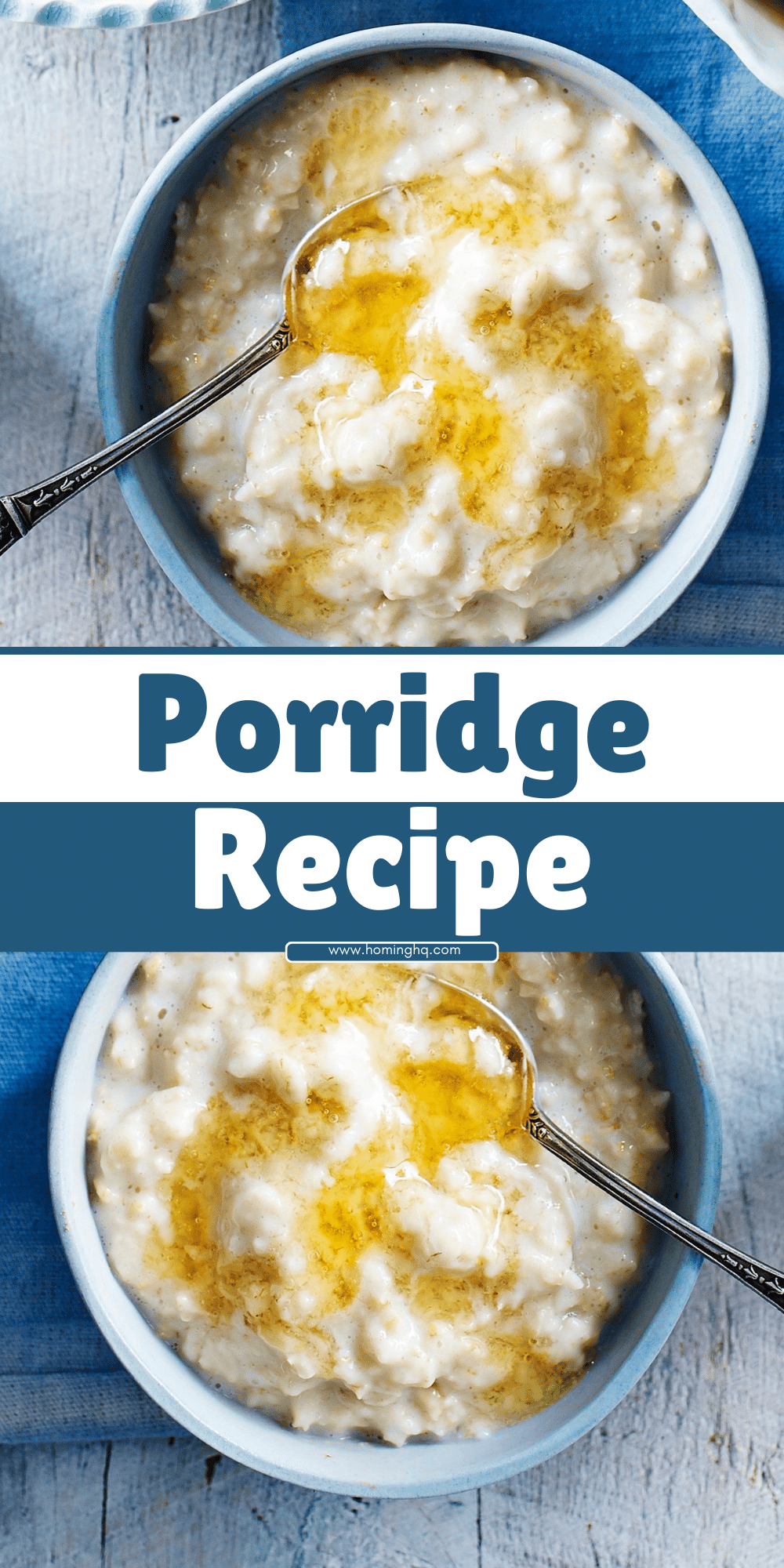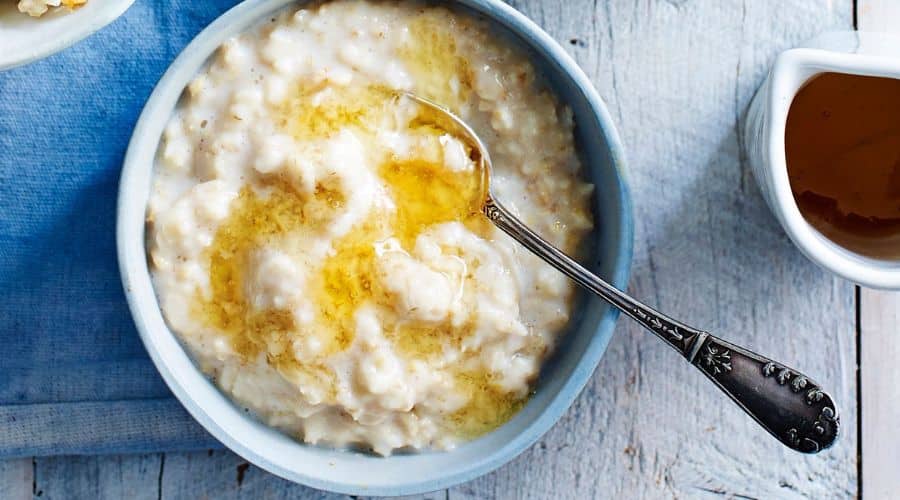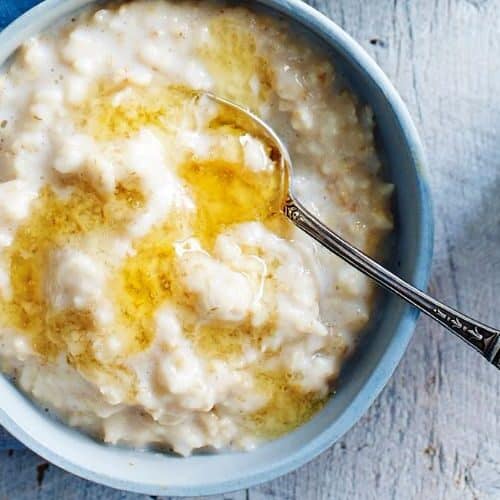All products are selected by our editorial team for quality. If you buy through our links, we may earn a small commission at no extra cost to you.
Porridge is a timeless, comforting dish that has been enjoyed across cultures for centuries.
At its core, porridge is simply a warm, creamy dish made by boiling grains in liquid—typically milk or water.
Its versatility allows it to be customized with a wide array of ingredients, making it a favorite for breakfast, lunch, or even dinner.
Whether it’s the simplicity of oats or a more exotic grain like quinoa or millet, porridge provides a nourishing, hearty start to the day.
In this post, we’ll explore the many variations of porridge, the health benefits of this humble dish, and tips to make it quickly and easily on busy mornings.
Whether you’re new to porridge or a seasoned fan, there’s always something new to try!

Types of Porridge
Porridge comes in various forms depending on the grain used. Here are some of the most popular types:
Oats Porridge
The classic choice for most people, oats porridge is quick to prepare, filling, and highly nutritious.
It’s made from rolled or steel-cut oats, cooked with water or milk. Oats are rich in soluble fiber, which helps lower cholesterol levels.
Rice Porridge
Rice porridge, often called congee in Asian cuisine, is a savory dish made by simmering rice in a large amount of water or broth.
This type of porridge is highly customizable, and it can be served with a variety of toppings, from pickled vegetables to eggs and soy sauce.
Millet Porridge
Millet is a gluten-free grain that makes for a creamy porridge when cooked with water or milk.
It’s a staple in many parts of Africa and Asia, offering a slightly nutty flavor and a good source of magnesium.
Quinoa Porridge
For those looking for a high-protein, gluten-free option, quinoa porridge is a great choice.
It’s made by cooking quinoa in water or milk until it becomes tender and creamy, and it can be sweetened with fruit or flavored with spices like cinnamon and vanilla.
Cornmeal Porridge
A popular dish in Caribbean and southern cuisines, cornmeal porridge is made from cornmeal, water, and milk, creating a rich and hearty bowl.
Often enjoyed sweetened with sugar, cinnamon, or nutmeg, cornmeal porridge is a comforting, filling option.
Other Regional Variations
In different cultures, porridge is prepared with local grains, creating unique flavors and textures.
From the Scandinavian “gröt” to the Indian “dalia,” there are many delightful variations to explore.
Health Benefits of Porridge
Porridge is much more than a comforting dish—it’s also a powerhouse of nutrients that can positively impact your health.
Packed with Nutrients
Porridge made from whole grains like oats, quinoa, or millet is rich in fiber, protein, vitamins, and minerals.
These nutrients support a variety of bodily functions, from boosting the immune system to improving digestion.
Promotes Digestive Health
The high fiber content in grains like oats and millet aids digestion and helps prevent constipation.
Porridge acts as a prebiotic, feeding the good bacteria in your gut and supporting a healthy microbiome.
Heart Health
Oats, in particular, are known for their ability to reduce cholesterol levels.
The soluble fiber in oats helps bind with cholesterol and flush it from the body, supporting overall heart health.
Energy and Weight Management
The combination of fiber and protein in porridge helps maintain steady energy levels throughout the day, keeping you fuller for longer.
This makes it a great option for those looking to manage their weight while still feeling satisfied.
Customizable for Special Diets
Porridge can easily be adapted for specific dietary needs.
For example, it can be made gluten-free using oats or quinoa, dairy-free using almond milk or coconut milk, or vegan with a variety of plant-based toppings.
How to Make Classic Oats Porridge

Making a simple bowl of oats porridge is quick and easy. Here’s how to do it:
Ingredients
- 1 cup of rolled oats (or steel-cut oats for a chewier texture)
- 2 cups of milk (or a dairy-free alternative like almond or oat milk)
- A pinch of salt
- Sweeteners or toppings of your choice (e.g., honey, fruit, nuts, cinnamon)
Step-by-Step Instructions
- Bring Liquid to a Boil
In a medium-sized pot, bring the milk (or water) and a pinch of salt to a boil over medium heat. - Add Oats
Stir in the oats once the liquid is boiling. Reduce the heat to a simmer and cook for 5-10 minutes, stirring occasionally, until the oats are soft and the porridge has thickened to your desired consistency. - Finish and Serve
Once the porridge is ready, remove it from the heat. Pour it into bowls and add your favorite toppings. For a sweeter touch, drizzle with honey or maple syrup. Add fresh fruit, nuts, or even a dollop of nut butter for extra flavor and texture.
Tips for the Perfect Oats Porridge
- If you prefer a thicker porridge, use less liquid. For a creamier texture, stir in extra milk at the end.
- For a savory porridge, skip the sweeteners and instead add a sprinkle of salt, pepper, and your favorite savory toppings like avocado or a poached egg.
Time-Saving Tips for Busy Mornings
While porridge is an easy and quick meal, some mornings can be more rushed than others. Here are some helpful tips to make porridge even faster:
Overnight Oats
If you don’t have time in the morning to cook, overnight oats are a perfect solution.
Simply mix rolled oats with your choice of milk (or yogurt) and let them sit in the fridge overnight.
In the morning, your oats will be soft and ready to eat with minimal effort.
Slow Cooker or Instant Pot
For those with a little extra time the night before, a slow cooker or Instant Pot can cook porridge while you sleep.
Just add your oats and liquid, set the timer, and wake up to a warm, ready-to-eat bowl of porridge.
Pre-Prep Ingredients
If you prefer to make porridge in the morning, you can speed up the process by pre-measuring your oats, liquid, and any spices the night before.
This saves you valuable time during your morning routine.
Serving Suggestions for Different Occasions
Porridge is incredibly versatile and can be enjoyed at different times of the day, for various occasions.
Whether you’re starting your morning or enjoying a comforting evening meal, there’s a porridge recipe for every occasion.
Quick Breakfast Porridge
Porridge is an ideal breakfast dish because it’s easy to make and can be customized to suit your tastes.
For a nutritious start to your day, top your porridge with fresh fruit, seeds, and a drizzle of honey or maple syrup.
You can also sprinkle some cinnamon for a warm, cozy flavor.
It’s the perfect combination of a balanced meal—carbohydrates, fiber, and healthy fats—giving you sustained energy to power through your day.
Porridge as a Light Lunch or Dinner
While porridge is often thought of as a breakfast food, it can also work well as a light lunch or dinner.
For a savory option, try adding sautéed vegetables, a poached egg, or even a sprinkle of cheese.
A warm bowl of porridge with a touch of spice or herbs makes a soothing meal that’s both hearty and nutritious.
You can even turn it into a grain-based risotto by cooking it with broth and adding proteins like chicken or tofu for a satisfying evening dish.
Special Occasion Porridge
Porridge can be the star of your holiday table or a comforting meal during cold months.
During festive seasons, consider making a special porridge like “Christmas Porridge,” which includes dried fruits, nuts, and spices, or a festive version with cranberry sauce and cinnamon.
For winter holidays, a spiced, creamy porridge made with eggnog and topped with gingerbread crumbs is sure to impress.
Porridge Recipes Around the World
Porridge has many variations around the globe, each with unique ingredients and cooking methods.
Exploring these recipes can introduce you to exciting new flavors and textures that highlight the diverse ways people enjoy porridge.
Congee (China)
Congee is a popular rice porridge in Chinese cuisine, often eaten for breakfast or as a comfort food.
It’s traditionally made by simmering rice in a large amount of water or broth, resulting in a creamy, velvety consistency.
Congee can be eaten sweet, with toppings like pickled vegetables, preserved egg, and a drizzle of soy sauce, or savory with ingredients like chicken, pork, and mushrooms.
Polenta (Italy)
In Italy, polenta is a traditional cornmeal-based porridge often served as a side dish or main course.
When cooked, polenta becomes smooth and creamy, and it can be topped with anything from a rich tomato sauce to sautéed mushrooms and cheese.
In some regions, it’s served as a hearty meal, often with braised meats or vegetables.
Dalia (India)
Dalia, also known as broken wheat porridge, is a popular dish in India. It’s a wholesome breakfast option packed with fiber.
Dalia is typically cooked with milk or water and can be sweetened with jaggery, a traditional unrefined sugar, or flavored with cardamom and saffron.
For a savory version, it is spiced with turmeric, cumin, and mustard seeds, and often served with vegetables.
Gröt (Sweden)
In Sweden, gröt (or porridge) is a beloved comfort food, especially during the cold winter months.
Made primarily with oats, gröt is served hot with a variety of toppings, including butter, sugar, cinnamon, or a dollop of jam.
The Swedish tradition of having porridge on New Year’s Day is especially notable, where the first person to find an almond hidden in the porridge is said to have good luck for the year.
Atole (Mexico)
Atole is a warm, sweet cornmeal porridge from Mexico, often enjoyed at breakfast or as an evening treat.
It’s made by cooking cornmeal with milk, sugar, cinnamon, and vanilla, creating a thick, comforting dish.
In many Mexican households, it’s served with tamales during special celebrations like Christmas and Día de los Muertos.
Mămăligă (Romania)
Mămăligă is a Romanian version of polenta, a staple dish in Eastern Europe.
The dish is made by cooking cornmeal with water and a pinch of salt, creating a thick and satisfying porridge.
It’s often served as a side dish with stews, meats, or cheese, and can be topped with sour cream or fried eggs for extra richness.
Frequently Asked Questions (FAQs)
1. How do I make my porridge creamier?
To make your porridge creamier, consider using whole milk or a rich plant-based milk like coconut milk.
If you prefer a dairy-free option, almond milk also adds a nice creamy texture.
For an even smoother consistency, you can add a spoonful of nut butter or a dollop of yogurt after cooking.
2. Can I make porridge in advance?
Yes, you can make porridge in advance.
For overnight oats, simply combine your oats and liquid, refrigerate them overnight, and they’ll be ready in the morning.
You can also cook porridge in a batch and store it in the refrigerator for a few days, reheating individual portions as needed.
3. Can I use steel-cut oats instead of rolled oats?
Steel-cut oats can be used in place of rolled oats, but they require a longer cooking time.
Steel-cut oats typically need about 20-30 minutes of cooking to reach a soft, creamy texture, compared to the 5-10 minutes required for rolled oats.
If you’re in a hurry, you can soak them overnight to reduce the cooking time.
4. How can I make my porridge more flavorful?
There are many ways to enhance the flavor of your porridge. You can add spices like cinnamon, nutmeg, or vanilla extract.
Sweeteners like honey, maple syrup, or brown sugar can also be mixed in.
For a savory porridge, consider adding salt, pepper, and ingredients like cheese, sautéed vegetables, or herbs.
5. Can I freeze porridge?
Yes, porridge can be frozen! To freeze porridge, cook it as you normally would, let it cool, and portion it into airtight containers.
It can be stored in the freezer for up to 1-2 months. When ready to eat, simply reheat in the microwave or on the stove, adding a bit more liquid to restore the creamy texture.
Conclusion
Porridge is not just a simple breakfast dish, but a nutritious, adaptable meal that can be enjoyed throughout the day.
Whether you prefer it sweet or savory, there are endless ways to customize your bowl to suit your tastes and dietary needs.
From the classic oats porridge to unique regional variations from around the world, there’s always something new to try.
The health benefits of porridge, including its fiber, protein, and heart-healthy properties, make it a perfect choice for anyone looking to start the day on a wholesome note.
And with the time-saving tips shared here, making a bowl of porridge can fit even the busiest morning schedules.
So next time you’re looking for a comforting meal that’s both nutritious and delicious, don’t forget to turn to porridge.
Feel free to experiment with different grains, toppings, and flavors, and enjoy the endless possibilities this humble dish has to offer. Happy cooking!

Porridge
Equipment
- 1 medium-sized pot
- 1 measuring cup (for oats and liquid)
- 1 spoon or whisk (for stirring)
- 1 bowl (for serving)
- Optional: Toppings (such as fruit, nuts, spices)
Ingredients
- 1 cup 240 ml rolled oats (or other grain of choice)
- 2 cups 480 ml milk (or any dairy-free alternative like almond or coconut milk)
- 1 pinch salt
- 1 tablespoon sweetener optional: honey, maple syrup, or sugar
- 1 teaspoon cinnamon optional for flavor
- 1/2 cup fresh fruit optional for topping
- 1 tablespoon nuts or seeds optional for topping
Instructions
- Boil the Liquid: In a medium-sized pot, bring 2 cups of milk (or water) to a gentle boil over medium heat. Add a pinch of salt to enhance the flavor.
- Add the Oats: Once the liquid is boiling, stir in the 1 cup of oats.Reduce the heat to low and simmer the mixture while stirring occasionally for about 5-10 minutes, until the oats absorb the liquid and soften to your desired consistency.
- Add Sweeteners or Flavor: If desired, mix in a tablespoon of sweetener such as honey or maple syrup, or sprinkle in cinnamon for extra warmth and flavor.
- Serve: Pour the porridge into bowls. Top with your choice of fruit, nuts, or seeds to add texture and flavor.
- Enjoy: Serve immediately, enjoying a warm, comforting, and nutritious bowl of porridge.
Notes
- For a creamier porridge: Use whole milk or a creamy plant-based milk like coconut milk. For a lighter porridge, opt for water or almond milk.
- Customize toppings: Porridge is a blank canvas! Add your favorite fruits, nuts, or spices to change the flavor every time. Consider a drizzle of honey or maple syrup for extra sweetness.
- Storage: Leftover porridge can be stored in an airtight container in the refrigerator for up to 3 days. Reheat by adding a splash of milk or water to restore the creamy texture.

